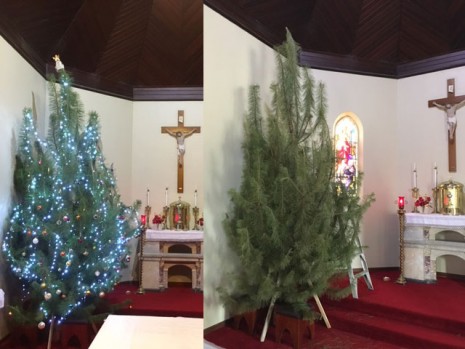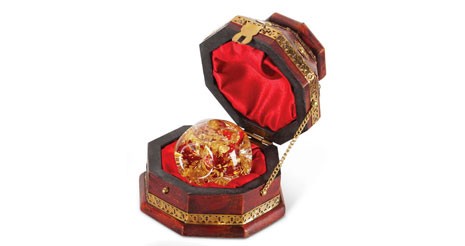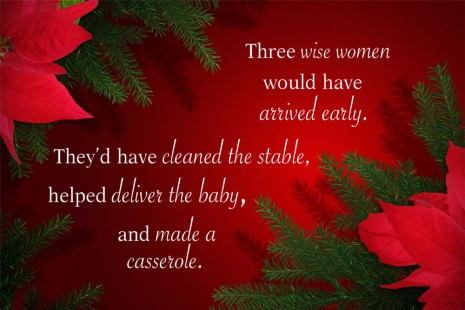Suddenly there wasn’t any Christmas anymore; just
a dead tree
If Christmas really is “the most wonderful time of the year” (though I’ve never liked that song), the days between Epiphany and the Baptism of the Lord might qualify as the least wonderful time of the year.
It’s in these days that Christmas draws to a close, the tree is removed and the lights are dismantled. I don’t have the heart to get rid of the Christmas cards yet — that can wait until the Presentation of the Lord. I know the hard-core also keep their trees up til then, but I think by 2 February there’d be more pine needles on the carpet than there would be on the branches.
As I removed the decorations from the Christmas trees in the parish church and presbytery, Evelyn Waugh’s Brideshead Revisited came to mind.
The strange spectacle of an undecorated tree, standing tall, dry and dead, evokes that most evocative of scenes, when Cordelia secretly observes a priest decommissioning a Catholic chapel
He took out the altar stone and put it in his bag; then he burned the wads of wool with the holy oil on them and threw the ash outside; he emptied the holy water stoup and blew out the lamp in the sanctuary and left the tabernacle open and empty, as though from now on it was always to be Good Friday. I suppose none of this makes any sense to you, Charles, poor agnostic. I stayed there till he was gone, and then, suddenly, there wasn’t any chapel there any more, just an oddly decorated room.
Blogging v. web design
Once the December issue of The Priest was sent to the printers, I had hoped to have more time blogging.
That was probably a bit naïve. For starters, the silly season of pseudo-Christmas — the unhappy successor of Advent — intervened. But in the less demanding days since Christmas, a lot of my “computer time” has been occupied with www.clergy.asn.au, which after The Priest is my biggest responsibility as editor of the ACCC.
My favourite WordPress developer, Elegant Themes, has finally — after two long years of development — released its flagship magazine theme, and I have spent a lot of time adapting it for the Confraternity’s purposes.

It’s far from finished, but if you follow the links to get a feel for the new look. The pages of the website, which relate information about the ACCC are complete. For example, visitors can register for the upcoming conference in Armidale.
Now I’m working on a much larger task: uploading every article ever published in The Priest. There are hundreds of these, and it’s a worthwhile project, I think, posting these online. They would have been a great help to my seminary studies, if only I’d had access to the archive when I was a student. Even now, I try to read one or two of the theological articles each month, as part of my systematic reading. The ‘prototype’ article is complete: Consecrated religious in Australian parish life. One formatted; 499 or so to go.
I’m treading old ground here. I wrote a very similar blog post back in November 2012. Back then I seemed to think I’d have the entire project finished in 12 months. Hmmm… I’ll do my best to blog regularly for the rest of these peaceful school holidays. But no promises!
Gold, frankincense and myrrh
Several weeks ago, some parishioners of mine showed me a beautiful set of boxes they dust off every Christmas.
The boxes were new and ornate, but made to look old — 1001 Arabian Nights old. The interiors were lined with red satin and contained gold, frankincense and myrrh. I was confident I could find something similar online, and sure enough, I found it:

“The Original Gifts of Christmas” — www.threekingsgifts.com
These boxes struck me as very Montessorian. I’ve blogged about Montessorian pedagogy before. It’s an effective and fruitful way of catechesis. Hence my interest in buying these myself. I located a “deluxe set” on Amazon which set me back $50, including postage and handling. Quite reasonable, really.
The chest of gold is octagonal, and contains a glass globe filled with water and large flakes of gold. The chest of frankincense is round, and contains large grains of incense. (I’m chewing on one now, which is a Mid-East custom apparently. It’s a pleasant tasting gum, but not so pleasant I’d do it again.) The chest of myrrh is square, and also contains large grains of incense. I’ve always presumed that the myrrh presented at Bethlehem was in the form of oil, but of course the Scriptures do not specify. It could just as easily have been presented in resin form. (I haven’t chewed on the myrrh, though apparently it is good for toothache!)
I put the set to good use during today’s Epiphany Mass. Some of the children who frequent Sunday Mass assumed the identities of Melchior, Caspar and Balthasar. (In other words, they hung hastily prepared name tags around their necks.)
During the homily, I called each “wise man” forward, and he processed from the back of the church bearing his box. At the sanctuary steps, he opened his box and showed his gift to the congregation before kneeling at the crib and placing his gift before the infant Jesus. While all that was happening, I shared some thoughts on each gift:
Even now, gold evokes royalty, and gold is a gift fit for a king. Especially the King of Kings!
We are called to join Melchior by presenting Jesus with our own gold. We can to that literally by giving money to the Church, and to charity. But we can present other sorts of gold also. Think of the old saying: “if you want to know how rich you are, think of all the things you have that money can’t buy.”
Our friends, our family, health, happiness — we can present these treasures to the Lord too. We can thank and praise him for these gifts, and detach ourselves from them by freely offering them back to God.
Incense, then as now, was used in worship. Caspar’s gift was fit for God, which is exactly who Jesus is: the Word Incarnate; God made man.
We can join Caspar by offering our own worship, especially at Mass. There’s no greater way to offer worship, than to participate in the Mass. But there’s an additional, more metaphorical way by which we can present the Lord with frankincense. Clouds of sweet-smelling incense rising towards Heaven evokes “the odour of sanctity,” or as St Paul puts it, “the fragrance of Christ.” (2 Cor 2:15)
Our own gift of incense to God is a desire to live a noble life. To show understanding and friendship to neighbours. To bring peace and joy to friends. To show mercy and affection to enemies. In other words, to make “the fragrance of Christ” our own.
The ancient Egyptians used myrrh in mummification. And the Jews used myrrh to anoint the bodies of the dead and prepare them for burial.
Hence Balthasar’s gift of myrrh evokes death. It’s a prophecy of the Lord’s passion. The next time myrrh is mentioned in the Gospels is at Calvary: “They offered him wine mixed with myrrh, but he refused to drink it.” (Mk 15:23)
We can imitate Balthasar’s gift of myrrh by offering sacrifice, especially in the little things. The hot weather, a stubbed toe, illness and tiredness are common discomforts which we can offer to the Lord in place of myrrh. We can smile at those who annoy us, hold our tongue and listen to others attentively, and make good use of the time God gives us.
I think anyone who spends any time on the Internet is familiar with the old joke about “three wise women” who aren’t mentioned in the Bible:
There’s no doubt that the three gifts of wise men are less practical. Tradition does hold, however, that the gold and frankincense financed the Holy Family’s flight into Egypt, and our Lady kept the myrrh in safekeeping, until three decades later she anointed her son’s body in preparation for his burial. So the gifts were certainly auspicious.
The greatest symbol of the Epipany however, is not gold, frankincense or myrrh, but the star which guided the Magi to Jesus. The star of Bethlehem is evocative of the light of Christ, which we carry within us — the fruit of our baptism and Confirmation, replenished by prayer and holy communion. In the word’s of today’s Solemn Blessing:
Since in all confidence you follow Christ,
who today appeared in the world as a light shining in darkness,
may God make you, too, a light for your brothers and sisters.
Amen.
New Year’s Eve
Some friends of mine are members of the young adults group attached to St Mary Star of the Sea, West Melbourne. They have asked me to publicise an initiative of theirs, which I’m very happy to do, not because they are good friends, but because this is a good initiative.
St Mary’s is a very beautiful church on the north-western edge of Melbourne’s CBD. The church was named in honour of Our Lady, Star of the Sea, because of its close proximity to the port. The church is built on top of a hill, and there was a time when the church could be seen from the sea. The church is now overshadowed by the city’s skyscrapers, but it is nonetheless an excellent vantage point to view Melbourne’s fireworks on New Year’s Eve.
With this in mind, the St Mary’s Young Adults persuaded the parish priest to open the church and permit the parish to host a New Year’s Eve party. Hence:
I might see you there!
Story-telling by chocolate
Every family has its own traditions. According to today’s Gospel, the Holy Family of Nazareth travelled to the holy city of Jerusalem every year to celebrate the Passover.
Closer to home, and to the present, my own family exchanges gifts straight after Christmas lunch. But before that, everyone gathers around the Christmas tree and sings a few hymns and happy birthday to Jesus, to focus everyone’s attention on the reason for the season.
As readers know, I introduced a new custom this year – the story of the First Christmas told with chocolate – which was successful enough, I think, that it will become a new tradition.
I know some readers ran their own ‘experiments’ in the last few weeks, applying the ‘chocolate script’ in many ways. Here are the applications I’ve heard about:
- Gifts for the King. As the story is narrated and each chocolate is named, it’s placed before the manger. This is a nice reminder that just as the Magi presented gifts for the newborn King, so can we. Not so much chocolate as kindness, forgiveness, joy in face of adversity.
- Fill the gap. The chocolates are piled in the centre, and as the story is told, the narrator pauses at the naming of each chocolate. Whoever correctly identifies the chocolate wins it.
- Links in a chain. The story is divided into parts, each placed in a bag or box with a chocolate. Each person reads their portion, which ends just before a chocolate is named, and the next person opens their bag to find the chocolate, and the next part of the story. People can start guessing which chocolate comes next.
- Treasure hunt. The chocolates are hidden in the garden. As the story is narrated, contestants have to correctly fill in the gap, and then be the first to find the named chocolate. (This is maybe not so good in a heat wave!)
- Pass the parcel. A variation on the links in a chain. Each layer of the parcel contains one of the chocolates and part of the story. The portion of the story stops just before the next chocolate is named, so people can try guessing the coming chocolate before the layer is unwrapped.
This chocolate script is surprisingly versatile. Add your own application of the script if it’s not already covered.
The Visitation
Luke tells us in today’s Gospel that Mary went as quickly as she could to Elizabeth’s. Did you notice that? Mary was a teenager when all this occurred. Like all young people, she was excited and wasted no time.
It’s a good reminder for us to foster spiritual childhood. To cultivate the enthusiasm and the generosity of youth.
When I was a teenager, I remember thinking that it must be easier for old people to be holy. I knew then (as I know now) lots of old people who were holy. So I thought holiness is like experience and wisdom. It comes with age.
But now that I’m older, and a little bit wiser, I know that’s not true. I know that young people can perform heroic feats of holiness. Great acts of generosity towards God and towards their neighbour. Young people are idealistic, and demanding of themselves, and so generous. Again and again at Adelaide’s Catholic Youth Festival a few weeks ago, I was moved by the generosity of the young people I was with, some new to the faith. They are willing to give everything to God. To give everything in service of their neighbour.
But what about us? As we get older, it’s easy to become complacent. We can become attached to small pleasures; unwilling to offer sacrifice. So here we have the example of our Blessed Mother — a teenager — who hastens to Elizabeth without delay. We can ask her to pray for us in these final days of Advent, that we can share her youthful spirit of service.
And then we have the example of Elizabeth and John. The unborn baby leaps for joy in his mother’s womb. I imagine every mother here can confirm the veracity of that tale.
Doctors confirm that babies recognise familiar voices, and respond to their environment well before they are born. Moreover, the bond between a mother and her child is profound. John would have literally shared his mother’s joy. The emotions which moved Elizabeth moved him too. And vice versa.
So Elizabeth and her child share each other’s joy. Please God, we’ll each have the opportunity on Christmas Day to share the joy of family and friends. And what a blessing, if like Mary and her child, we can be a source of joy. So we can ask that favour of our Blessed Mother too. That she prays for each of us, that we can be a source of joy to others.
Today’s prayers, today’s readings, these last days before Christmas all point us to the wonder of the Incarnation. The scandal of the Incarnation.
God became one of us. God assumed our human nature, so that he could redeem us in and through our humanity. And then he asks us to assist him. To become co-redeemers. To offer our own humanity — the daily humdrum of life; small sacrifices; moments of joy — for the salvation of the world.
Christmas invites us to contemplate the sacred humanity of Jesus Christ. In the history of the Church, some mystics have suggested that the Lord’s sacred humanity is like a diving board, which allows us to plunge into the mystery of God. Into the wonder of the Trinity: Father, Son and Spirit.
But St Teresa of Avila — one of history’s greatest mystics, a Doctor of the Church — rejects that idea. The sacred humanity of Jesus, she says, and the scandal of the Incarnation, and the mystery of Christmas — none of this is a “diving board” we leap from. It’s not something we leave behind. It is the ocean we swim in when we are immersed in God.
Mary carried God in her womb. She nursed God in her arms. And at this very Mass, we can hold God in our hands or receive him on our tongue. Because the Word became flesh, and dwelt among us.
Chocolate Christmas
The genius of Santa Claus is that he builds up children’s anticipation of Christmas. They really look forward to the day. “Nine more sleeps until Christmas,” and all that.
So those presents under the tree on Christmas morning not only evoke the gifts which the wise men presented at Bethlehem; they also provoke the excited expectation which must have captivated Mary and Joseph. It’s good practice for an adult approach to Advent.
The downside of Santa is that he can distract from the religious meaning of Christmas. The North Pole and presents can easily overshadow Bethlehem and faith. So Christian families everywhere deliberately refocus attention on the Nativity on Christmas Day.
In our family, the exchange of Christmas presents after lunch is always preceded by three or four Christmas carols, and a rendition of “Happy Birthday” to Jesus. It works — I grew up a believer, didn’t I? — but this year, I’m going to experiment with an additional item, which places the scriptural account of Christmas front and centre:
Basically, I’m proposing a novel excuse to recite the scriptural account of the Lord’s Nativity. Here’s a quick example:
In the days of Caesar Augustus, a census was called which counted every man in the civilised world. So Joseph and Mary set out from Nazareth to Bethlehem, following a familiar but Rocky Road.
I didn’t invent this idea, but I’ve refined and improved it, so that:
- the chocolate featured is available at Australian supermarkets;
- all mention of chocolate occurs at the end of a sentence; and
- the narrative hews closely to the Gospels of Luke and Matthew.
You can download my version right here. If you print it at 100% scale on both sides of an A4 sheet, you’ve got yourself a formatted booklet.
This year, I’m collaborating with my three young nephews, who will each have one third of the chocolate cache. When I name one of the chocolates in their possession, they have to jump up, chocolate in hand, and repeat the name. That should keep everyone listening.
Maybe in future years, we can pile the chocolates in the middle of the room, and people who want a particular chocolate bar have to be the first to correctly fill in the gap when the narrator pauses. A contest like that can also guarantee that people listen the story.
We’ll see how it lands this year. Why not try it yourself?
(NB: my nephews don’t read this blog, but some of their aunts and uncles do. The boys intend to surprise the family, so don’t tell them you saw it here first!)























Comments